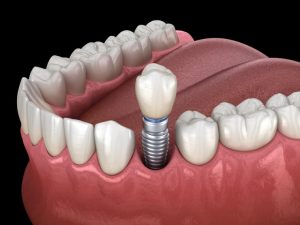Filling the gap: the missing tooth
A missing tooth or teeth can spoil your smile, and make eating and speaking difficult. Today there are many options available to help you ‘fill the gap’ … Which is the most suitable for you?
The implant

A new artificial tooth can be attached to an implant. This can be an excellent way of replacing a missing tooth or teeth, because other teeth are not involved. An implant is like an artificial tooth root, and is placed into the jaw bone where a tooth has been lost. One or more implants can be used, depending on the size of the space. After a time of healing (usually a few months) an artificial tooth is attached to the implant. Treatment takes between six to twelve months to complete. Not everyone has the right jaw structure for this treatment, and you will need to be checked by your dentist to see if an implant is the right option for you.
The Bridge
 A bridge is an artificial tooth supported by the teeth on either side of the space. Your dentist prepares your teeth on either side of the gap, and takes a mould which is sent to a dental technician. The dental technician makes the comp lete structure , using porcelain (for appearance) and a metal core (for strength) . Your dentist then places the bridge into your mouth . Bonded bridges that do not require shaping of the neighbouring teeth are sometimes used. Stronger materials are sometimes necessary for bridges used in back teeth. Your dentist may use an all-metal, gold bridge for this. A bridge is a long term , very attractive way of helping you fill the gap.
A bridge is an artificial tooth supported by the teeth on either side of the space. Your dentist prepares your teeth on either side of the gap, and takes a mould which is sent to a dental technician. The dental technician makes the comp lete structure , using porcelain (for appearance) and a metal core (for strength) . Your dentist then places the bridge into your mouth . Bonded bridges that do not require shaping of the neighbouring teeth are sometimes used. Stronger materials are sometimes necessary for bridges used in back teeth. Your dentist may use an all-metal, gold bridge for this. A bridge is a long term , very attractive way of helping you fill the gap.
The Denture
 There are several types of dentures suitable as a short or medium term tooth replacement. The plastic partial denture fits on the gum and sometimes has wire clasps to hold it in place . The metal precision partial denture fits exactly with clasps and rests on existing teeth. Both are removable, and you take them out to clean.
There are several types of dentures suitable as a short or medium term tooth replacement. The plastic partial denture fits on the gum and sometimes has wire clasps to hold it in place . The metal precision partial denture fits exactly with clasps and rests on existing teeth. Both are removable, and you take them out to clean.
